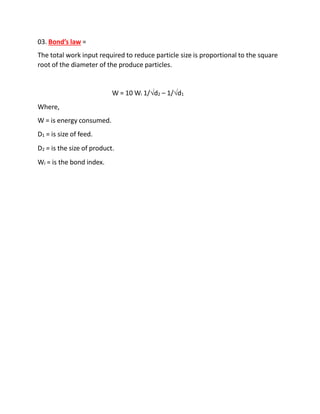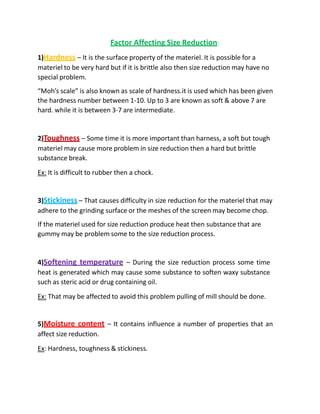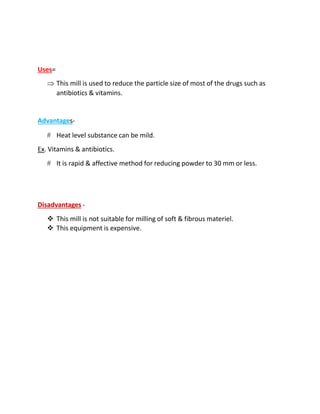sizereduction-191227021215 (1).pptx
- 1. SIZE REDUCTION Size reduction is the operation carried out for reducing the size of bigger particles into smaller one of desired shapes & size with the help of external forces. Comminution is another term used for size reduction. The row materiel is generally present in the large size which cannot be used by the industries so, the materiel needs to be converted into smaller particle or powder. Conversion of large materiel into smaller sized particles is called as ŌĆ£size reductionŌĆØ. OBJECTIVES OF SIZE REDUCTION: In the materiel process industries size reduction or commination is useful carried out in order to- 1. Increasesthe surface area because in mostreactions involving solidparticles the rate of reaction is directional to the ratio area with the second phase. 2. A materiel into very small particles in ordered to separate the valuable substance among the two constituents. 3. Pharmaceutical capsules, insufflation & suppositories & ointments require smaller particle size. 4. To allow the rapid penetration of solvent in crude drugs to extract phytochemicals. 5. In case suspensions, fine particles size is important because it reduce the rate of sedimentation. 6. To improve the handling characteristics, to mixed solid particle more ultimately.
- 2. MECHANISM OF SIZE REDUCTION Size reduction involves the following mechanisms: 1. Cutting. 04. Attrition. 2. Compression. 05. Combination of impact & attrition. 3. Impact. 1. Cutting = The materiel is cut by sharp blade. It is useful for size reduction of fibrous or very solid. Ex. Cutter mill. 2. Compression = In this mechanism the size reduction is achieved by crushing the materiel by application of pressure. Ex. Roller mill. 3. Impact = Impact occurs when the materiel is kept stationary & is hit by an object moving at the high speed or when the materiel is kept moving at high speed against a stationary object. Ex. Hammer mill. This action continuous until particles of required size are obtain. 4. Attrition = It involve collision between the two-particle having high kinetic energy or a high velocity particle with a stationary phase. Ex. Roller mill & fluid energy mill. 5. Combination of impact & attrition = this type of mechanism involves both effects i.e. impact & attrition. Ex. Ball mill, is used in the combination of impact & attrition.
- 3. LAWS GOVERNING SIZE REDUCTION: They are used to predict energy requirement for size reduction. 1. RittingerŌĆÖs law. 2. KickŌĆÖs law. 3. BondŌĆÖs law. 4. Holmes law. 5. Harris law. 01]. RittingerŌĆÖs law ŌĆō The energy required in crushing is proportional to the new surface crated as a result of particle fragmentation. i.e. Energy ’üĪ New surface Energy = [ K .1/D2 ŌĆō 1/D1] Where, D1 & D2 is the particle size at start & end of the process respectively. K = KR . Kc Where, KR is RittingerŌĆÖs constant & fc is crushing strength of material. 02]. KickŌĆÖs law = The energy required to reduce the size of particle is proportional to the square root of the diameter of the product particles. E = Kk In [d1/d2] E = energy required. KK = kickŌĆÖs constant. D1 = average initial size of particle. D2 = final particle size.
- 4. 03. BondŌĆÖs law = The total work input required to reduce particle size is proportional to the square root of the diameter of the produce particles. W = 10 Wi 1/’ā¢d2 ŌĆō 1/’ā¢d1 Where, W = is energy consumed. D1 = is size of feed. D2 = is the size of product. WI = is the bond index.
- 5. Factor Affecting Size Reduction: 1)Hardness ŌĆō It is the surface property of the materiel. It is possible for a materiel to be very hard but if it is brittle also then size reduction may have no special problem. ŌĆ£MohŌĆÖs scaleŌĆØ is also known as scale of hardness.it is used which has been given the hardness number between 1-10. Up to 3 are known as soft & above 7 are hard. while it is between 3-7 are intermediate. 2)Toughness ŌĆō Some time it is more important than harness, a soft but tough materiel may cause more problem in size reduction then a hard but brittle substance break. Ex: It is difficult to rubber then a chock. 3)Stickiness ŌĆō That causes difficulty in size reduction for the materiel that may adhere to the grinding surface or the meshes of the screen may become chop. If the materiel used for size reduction produce heat then substance that are gummy may be problem some to the size reduction process. 4)Softening temperature ŌĆō During the size reduction process some time heat is generated which may cause some substance to soften waxy substance such as steric acid or drug containing oil. Ex: That may be affected to avoid this problem pulling of mill should be done. 5)Moisture content ŌĆō It contains influence a number of properties that an affect size reduction. Ex: Hardness, toughness & stickiness.
- 6. In general, the materiel should be dry or wet & not nearly dame. Usually less than 5% of moisture is suitable for dry substance & more than 50% for wet substance.
- 7. HAMMER MILL Principle: The hammer mill obtained on the principle of impact b/w rapidly moving hammer mounded on a rotated & the powder materiel. Construction: The hammer mill can be horizontal or vertical soft type; it is usually made up of stainless steel with impact surface made up of extremely resisting materiel. The hammer may have several shapes. The blade of hammer can be flat edges or shark edge. The unit is enclosed with a chamber containing removable screen through which the materiel passes. Working: The hammers are allowed to be an continues motion (8000-15000 revolution per mint.) the feed materiel is placed into hopper which flows vertically down & then horizontal, while hammers are in continues motion. The rotating hammerŌĆÖs beat the materiel to yield smaller particle then these particles passes through the screen & collection in the receiver. Uses= ’ā× It is used for grinding of powderŌĆÖs which depend on speed of hammer. ’ā× It is used to mill dry materiel, wet filter presses cakes, ointment etc.
- 8. Advantages- ’ĆŻ It is easily to setup & use. ’ĆŻ It occupies small space. ’ĆŻ It is versatile. Disadvantages- ’üČ The screen may get clogged. ’üČ Hammer cannot be used to mill sticky, fibrous & hard materie.
- 9. BALL MILL Principle- Th ball mill work on the principle of impact between the rapidly moving ball & the powder materiel, both enclose in a hollow cylinder. At low speed the ball role over each other attrition will be predominant mode of action. Thus, in boll mill impact or attrition or both are responsible for size reduction. Construction: It consists of a hollow cylinder which is mounted on a metallic frame in such a way that it can be rotated on its longitudinal access length of cylinder is greater than its diameter. The cylinder is made up of mettle & usually lime with frame. The cylinder contain boll the size of boll depends upon size feed. The boll is made up of steel or iron. Working- the drug to e ground is put into the cylinder. A fixed number of bolls are introduced & the cylinder is closed. The mill Is allowed to rotate on its longitudinal access. The speed of rotation Is very important at low speed the boll role over each other & attrition will be predominate mode of action.
- 10. At correct speed, the centrifugal course occurs as a result the ball are picked up by the mill boll & carried nearly to the top where they contact with the boll & foul to bottom. In this way impact occurs & size reduction is affective. At very high speed the boll is through out to the boll by the centrifugal force, hence grinding will not occurs. Uses= ’ā× It is used of grinding of particle size having diameter 100-5 mm ’ā× Stainless steel was are preferred for production of ophthalmic & parenteral products. Advantages- ’ĆŻ It can produce very fine powder. ’ĆŻ It can be used for batch operation. ’ĆŻ It is midtable for both wet & dry grinding process. ’ĆŻ Toxic substance also be granted into small a particle. Disadvantages: ’üČ It is very noisy mill/machine. ’üČ It very slow process. ’üČ Where occurs from the wall as well as casing which may result in contamination of the product
- 11. FLUID ENERGY MILL Principle- fluid energy mill obtains in the principle of impact & attrition. In this equipment the feed is suspended within a high velocity collagen between the suspended particle. Construction- It consists of elliptical pipe has a Hight of about 2 meter & diameter of 20-200 mm, the ill surface is made up of stainless steel, grinding nozzles may be plays tangential or opposed to initial flow path of powder. Compressed air of 600 kilo pascal -1 mega pascal is used. Working: Powder is introduced through the inlet. The air entering to the grinding nozzles transport the powder to elliptical pipe. The suspended particle colloid with each other & break. The resultant small particle is carried to outlet & removed y cyclone separator whereas the courses particle undergoes recirculation in chamber, where they colloid again with new incoming feed. The powder remains in the mill until its size reduced sufficiently.
- 12. Uses= ’ā× This mill is used to reduce the particle size of most of the drugs such as antibiotics & vitamins. Advantages- ’ĆŻ Heat level substance can be mild. Ex. Vitamins & antibiotics. ’ĆŻ It is rapid & affective method for reducing powder to 30 mm or less. Disadvantages - ’üČ This mill is not suitable for milling of soft & fibrous materiel. ’üČ This equipment is expensive.
- 13. EDGE RUNNER MILL Principle= The size reduction is done by crushing (compression), due to the heavy weight of stones. Shearing course is also involved during the movement of stones. Construction = It consists of two heavy rollers (several tones). The roller moves on the bed which is made up of stone. Each roller has central shaft & revolve its axis. Working= The materiel to be ground is placed on the bed with the help of stopper. It is kept in the path of the stone wheel. The stones revolve on their axis. The outer part of the wheel here to travel greater distance then inner so that size reduction is achieved by shearing as well as crushing. At the last powder is collected & pass through the sims. Uses= ’ā× It used of grinding tough materiel to fine particle. Advantages-
- 14. ’ĆŻ This mill does not require attrition during operation. Disadvantages: ’üČ This mill occupies more space ’üČ It is not use for sticky materiel. ’üČ The contamination of product with roller is possible.
- 15. END RUNNER MILL Principle- The materiel is getting crushed due to weight of heavy pestle & shearing force which get applied during the movement of these stones. Construction & Working: It can be considered as a mechanical mortar & pestle, where the mortar is shallow & the bottom of the pestle is flat rather than round. It consists of bed of stone or mild steel with an eccentrically placed, vertical cylindrical dumb bell-shaped roll supported by a horizontal shaft such when the shaft is rotated, friction between contacting surfaces of the bed & stone results in rotation of the roll & grinds the materiel placed on the bed. A scraper forces the materiel to the grinding surface. It can be used for size reduction of crystalline or brittle materiel. Uses= ’ā× It is suitable of fine grinding.
- 16. Disadvantages - ’üČ End runner mill is not suitable for drugs, which are in unbroken or slightly broken condition.

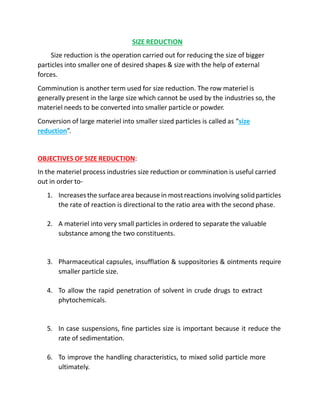
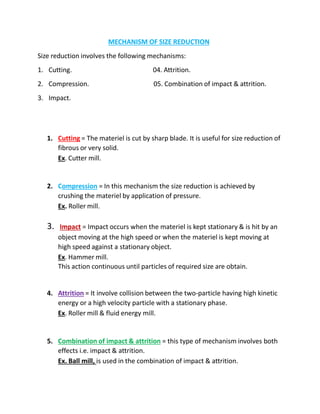
![LAWS GOVERNING SIZE REDUCTION:
They are used to predict energy requirement for size reduction.
1. RittingerŌĆÖs law.
2. KickŌĆÖs law.
3. BondŌĆÖs law.
4. Holmes law.
5. Harris law.
01]. RittingerŌĆÖs law ŌĆō
The energy required in crushing is proportional to the new surface crated as a
result of particle fragmentation.
i.e. Energy ’üĪ New surface
Energy = [ K .1/D2 ŌĆō 1/D1]
Where, D1 & D2 is the particle size at start & end of the process respectively.
K = KR . Kc
Where, KR is RittingerŌĆÖs constant & fc is crushing strength of material.
02]. KickŌĆÖs law =
The energy required to reduce the size of particle is proportional to the square
root of the diameter of the product particles.
E = Kk In [d1/d2]
E = energy required.
KK = kickŌĆÖs constant.
D1 = average initial size of particle.
D2 = final particle size.](https://image.slidesharecdn.com/sizereduction-1912270212151-230808054449-e161674a/85/sizereduction-191227021215-1-pptx-3-320.jpg)
